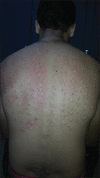Common Allergens Prevalent in and Around Ambala, Haryana: An Intradermal Study among Patients with Asthma and Allergic Rhinitis and Atopic Dermatitis
- PMID: 30078875
- PMCID: PMC6052743
- DOI: 10.4103/ijd.IJD_438_17
Common Allergens Prevalent in and Around Ambala, Haryana: An Intradermal Study among Patients with Asthma and Allergic Rhinitis and Atopic Dermatitis
Abstract
Objective: Identification of allergens by intradermal test in patients with asthma, allergic rhinitis, and eczema.
Materials and methods: Intradermal test was performed in 100 patients of Ambala over an 8-year period to identify the common allergens. A total of 197 allergens including 50 types of pollen, 19 fungi, 17 insects, 14 types of dust, 6 animal dander, 7 types of fabric and feather and 82 types of foods, dust mite, and parthenium were tested.
Results: In this study, the major allergens were pollen (51%) followed by foods (28.9%), insects (26.9%), fungus (12.6%), dusts (6.7%). Among pollen allergens, Brassica campestris (8%) was a major allergen followed by Ageratum conyzoides (7%) and Artemisia scoparia (6%) Cannabis sativa, Cynodon dactylon and Maerua arenaria (5%). Among the fungal group, Alternaria tenuis, Aspergillus flavus, Aspergillus fumigates, Candida albicans, Penicillium sp., Rhizopus nigricans (3%), Fusarium solani (2%) were found. In the insect group, mosquito (7%), ant (6%), grasshopper (5%), locust (male), moth, and house fly (4%) were the major allergens. Among the dust allergens, grain dust rice (3%), straw dust, house dust, and grain dust bajra (2%) were found. Among the food allergens, prawn (5%), almonds, Baker's yeast, Bengal gram (3%) and mushroom, mango ripe, rajma, cinnamon, chocolate, beans fresh, and areca nut (2%) were found.
Conclusion: It can be said that the knowledge may help to create a mapping of allergens in this area and help to treat patients by immunotherapy or avoidance strategy.
Keywords: Allergens; asthma; atopic dermatitis; intradermal test; nasobronchial allergy.
Conflict of interest statement
There are no conflicts of interest. What is new? The antigens prevalent in this part of India are mapped which will help in selecting the most cost effective panel for skin allergy testing in various parts of India.Incorporation of low cost immunotherapy will be possible to patients of asthma, allergic rhinitis and eczema.
Figures
Similar articles
-
A study of skin sensitivity to various allergens by skin prick test in patients of nasobronchial allergy.Lung India. 2009 Jul;26(3):70-3. doi: 10.4103/0970-2113.53228. Lung India. 2009. PMID: 20442839 Free PMC article.
-
Sensitization to common allergens and its association with allergic disorders at age 4 years: a whole population birth cohort study.Pediatrics. 2001 Aug;108(2):E33. doi: 10.1542/peds.108.2.e33. Pediatrics. 2001. PMID: 11483843
-
The pattern of sensitisation to inhalant allergens in omani patients with asthma, allergic rhinitis and rhinoconjunctivitis.Sultan Qaboos Univ Med J. 2008 Nov;8(3):319-24. Sultan Qaboos Univ Med J. 2008. PMID: 21748078 Free PMC article.
-
[Hypersensitivity to common allergens in the central region of Coahuila].Rev Alerg Mex. 1993 Nov-Dec;40(6):150-4. Rev Alerg Mex. 1993. PMID: 9296819 Review. Spanish.
-
The effect of immunotherapy on cross-reactivity between house dust mite and other allergens in house dust mite -sensitized patients with allergic rhinitis.Expert Rev Clin Immunol. 2021 Sep;17(9):969-975. doi: 10.1080/1744666X.2021.1968834. Epub 2021 Aug 18. Expert Rev Clin Immunol. 2021. PMID: 34388949 Review.
Cited by
-
Seasonal variation and size distribution in the airborne indoor microbial concentration of residential houses in Delhi and its impact on health.Aerobiologia (Bologna). 2021;37(4):719-732. doi: 10.1007/s10453-021-09718-3. Epub 2021 Jul 3. Aerobiologia (Bologna). 2021. PMID: 34248257 Free PMC article.
-
Immunotherapy: Current indications and recommendations in the management of ocular allergy.Indian J Ophthalmol. 2025 Apr 1;73(4):526-536. doi: 10.4103/IJO.IJO_2853_23. Epub 2024 Sep 19. Indian J Ophthalmol. 2025. PMID: 39297491 Free PMC article. Review.
References
-
- Pawankar R, Canonica GW, Holgate ST, Lockey RF. Executive Summary. Wisconsin: World Allergy Organisation; 2011. White Book on Allergy 2011-2012.
-
- Patel B, Lockey RF, Kaliner MA, Aljubran SA, Bush RK. Aeroallergens. [Last accessed on 2018 Apr 25]. Available From: link for AQ7: https://emedicine.medscape.com/article/137911-overview .
-
- Kern RA. Dust sensitization in bronchial asthma. Med Clin North Am. 1921;5:751.
-
- Storm van Leeuwen W. Philadelphia Pa: J.B. Lippincott; 1925. Allergic Diseases: Diagnosis and Treatment of Bronchial Asthma, Hay Fever and Other Allergic Diseases.
-
- Shivpuri DN. Clinically important pollen, fungal and insect allergen in nasobronchial allergy in India. Aspects Allergy Appl Immunol. 1980;13:19–23.
LinkOut - more resources
Full Text Sources
Other Literature Sources


